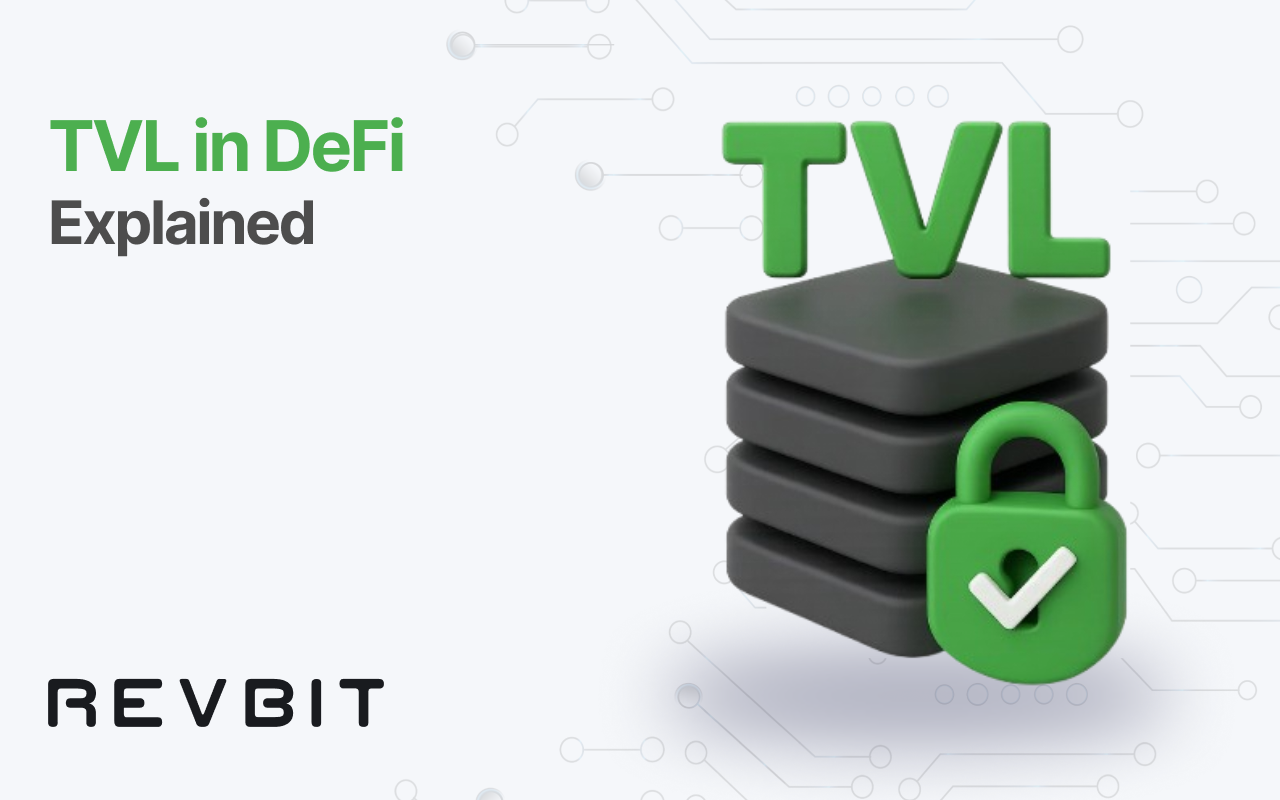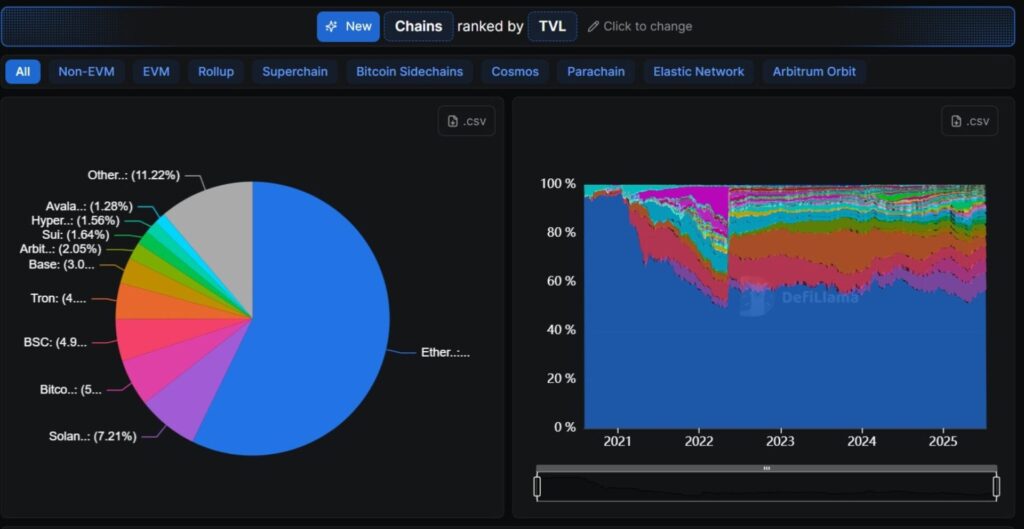
Total Value Locked, or TVL, acts as a key gauge in the decentralized finance space, showing how much capital sits tied up in protocols. As we push through the latter months of 2025, with DeFi volumes climbing amid stable market conditions post-halving, understanding what sways this metric helps spot trends and risks. TVL in DeFi tracks the worth of assets stashed in smart contracts for lending, staking, or trading, often in billions across chains like Ethereum or Solana. By the way, you can find out the current SOL exchange rate directly on Revbit.
Factors influencing TVL range from market moods to protocol tweaks, making it a pulse check for the sector’s health. This article breaks down what TVL stands for, what pulls its numbers up or down, and why it matters for anyone dipping into decentralized setups. From basic calcs to deeper drivers, we’ll cover the essentials to grasp this core measure.
What TVL Represents in DeFi
TVL boils down to the total dollar value of crypto locked in a protocol or chain at any point. It’s like checking a bank’s deposits to see its size—higher TVL hints at more trust and activity. Total value locked calculation sums assets in contracts, priced in USD for easy compares. For example, if a lending app holds $500M in ETH and $300M in stables, TVL hits $800M.
Why track it? It signals liquidity—high TVL means smoother borrows or trades without big slips. In 2025, with DeFi TVL topping $150B, it’s a benchmark for growth, drawing investors to hot spots. But it’s not perfect—inflated by double-counts in layered protocols or short-term pumps from airdrops. Still, sites like DefiLlama tally it real-time, giving clear views across ecosystems.
Key Factors Affecting TVL
Several elements tug at TVL, from broad market swings to protocol-specific changes. Market sentiment plays huge—bull runs pull in capital as prices climb, boosting locked values; bears trigger pulls, shrinking totals. Yields matter too—high APYs from farming or staking lure deposits, like 10-20% on stables drawing billions.

Protocol upgrades sway it—Ethereum’s Dencun cut fees, spiking TVL 30% as users flocked back. Security breaches tank confidence, like 2024’s exploits draining $2B and halving affected protocols. Liquidity incentives, such as token rewards, pump short-term locks but risk dumps post-end. External stuff like regs—MiCA in EU stabilized flows, upping TVL in compliant zones. Token prices directly hit—SOL’s rise doubled Solana’s TVL in months. These drivers show TVL as a live barometer, reacting to internal tweaks and outer forces.
How Market Correlations Influence TVL
TVL ties tight to broader crypto trends and economy signals. Bitcoin’s price often leads—its rallies pull alts up, inflating locked values across chains. In 2025, with BTC above $60K, DeFi TVL correlates 0.8 with its moves, per CoinMetrics. Stock markets link too—S&P dips trigger risk-off, draining liquidity from protocols.
Interest rates sway—Fed cuts draw capital to yields, boosting staking TVL. Stablecoin flows matter—USDT inflows signal fresh money entering DeFi, upping locks. Chain competitions shift it—Solana’s low fees pulled TVL from Ethereum during congestion. External shocks like regs or hacks ripple—positive news like ETF nods spike inflows. Tracking these helps predict TVL swings, guiding when to lock or pull.
Common Correlations and Their Impact
| Factor | Average TVL Impact | Example | Notes |
|---|---|---|---|
| BTC Price Rise | +20-30% | Halving rallies | Direct correlation |
| Yield Increases | +15% | APY hikes | Attracts deposits |
| Network Upgrades | +10-25% | Dencun rollout | Boosts efficiency |
| Security Breaches | -40% | Exploit events | Drains confidence |
| Regulatory News | ±20% | MiCA approval | Positive up, bans down |
| Stablecoin Inflows | +10% | USDT mints | Signals liquidity |
| Market Dips | -15-25% | Bear phases | Risk-off pulls |
These show TVL’s sensitivity to shifts.
Tools for Tracking TVL
Keeping tabs on TVL helps spot hot protocols or chains. DefiLlama leads with real-time dashboards across 100+ nets, showing breakdowns by category like lending or DEXs. Dune Analytics lets custom queries for deeper dives, like TVL by token.
Chain-specific like L2Beat tracks rollups, highlighting flows. Apps like Zapper aggregate personal TVL across wallets. In 2025, AI add-ons predict shifts based on sentiments. For swaps during TVL hunts, Revbit offers crypto-to-crypto without KYC, quick and private for testing protocols. These tools make monitoring easy, turning data into decisions.
Tips for Navigating TVL Changes
Spotting shifts keeps you ahead. Here’s a marked list of pointers.
-
Watch yields: High APYs signal inflows, but check sustainability.
-
Track news: Upgrades or partnerships spike TVL—act early.
-
Diversify chains: Spread across Ethereum, Solana to balance risks.
-
Use alerts: Set on DefiLlama for protocol changes.
-
Analyze ratios: TVL to market cap shows over/undervalued.
-
Factor externals: Watch BTC trends for correlations.
-
Review history: Past data predicts reactions to events.
These help turn TVL into actionable insights, dodging traps.
Wrapping Up
TVL serves as a vital window into DeFi’s vitality, reflecting locked capital’s ebb and flow amid market dynamics. From its role as a health check to the myriad factors like yields, upgrades, and sentiments that sway it, grasping this metric equips anyone navigating decentralized spaces. Correlations with broader trends underscore its interconnected nature, while tools and tips make tracking accessible for informed moves. Challenges like breaches or regs add layers, but understanding drivers turns data into strategy.
As 2025’s landscape shifts with tech advances and adoption, keeping an eye on TVL not only spots opportunities but guides safer plays. Dive deeper with resources, test simple calcs, and build habits around monitoring—this not only demystifies the space but positions you to capitalize on its growth, turning insights into smarter engagements with DeFi’s evolving world.